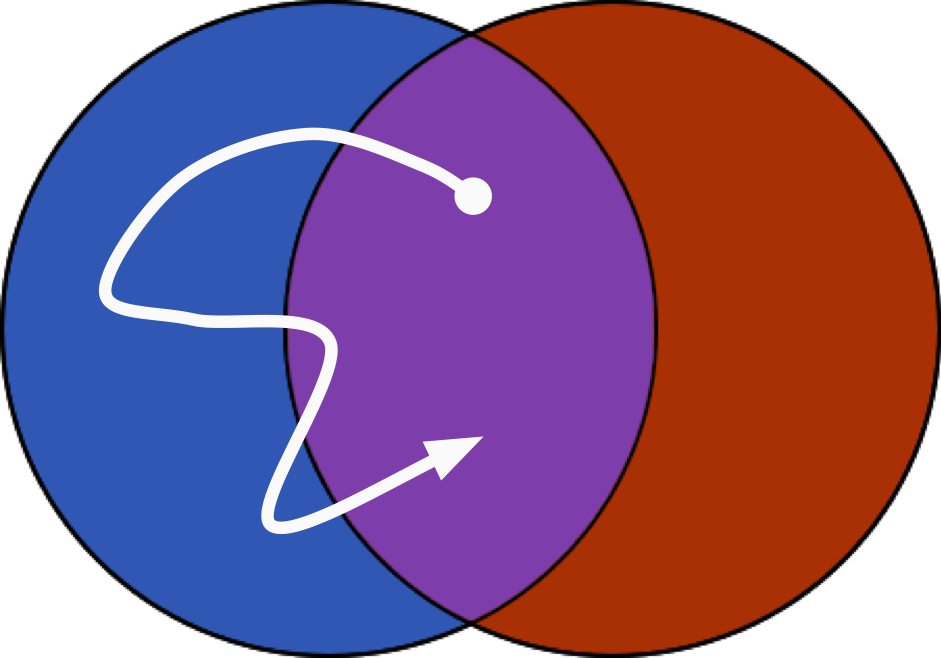Ensembles apply to trajectories, not frames
It is common to initially think of ensembles as applying on a frame-by-frame basis. However, ensembles are only valid on trajectories, not individual frames. To explain this, let’s consider a couple simple common misconceptions.
Combining volume ensembles doesn’t combine volumes
It might seem like Ensemble(volume_A) & Ensemble(volume_B) should be the
same as Ensemble(volume_A & volume_B). But this is absolutely not the
case. We can see this easily by using PartOutXEnsemble as the example
ensemble. PartOutXEnsemble(volume) creates an ensemble in which at
least one frame must be outside of volume. So the difference between
and-ing together the two ensembles vs. and-ing together the two
volumes can be described like this:
PartOutXEnsemble(volume_A) & PartOutXEnsemble(volume_B): there is at least one frame in the trajectory outside ofvolume_A, and at least one frame outside ofvolume_B. These two frames do not need to be the same frame.PartOutXEnsemble(volume_A & volume_B): there is at least one frame which is outside ofvolume_A & volume_B, which is the intersection ofvolume_Aandvolume_B.
Note that the second case does NOT mean that a single frame is
simultaneously outside of both volume_A and volume_B: it is outside
the intersection, not the union. If what you want is a ensemble of
trajectories which contain at least one frame that is simultaneously outside
of volume_A and outside of volume_B, you can write that as
PartOutXEnsemble(volume_A | volume_B).

The above trajectory is in PartOutXEnsemble(volume_A & volume_B) but not
in PartOutXEnsemble(volume_A) & PartOutXEnsemble(volume_B). To be in
that ensemble, it would need to have a frame in the red area, or the outside
both volumes in the white area. The volume given by volume_A & volume_B
is the purple area, and some frames are outside of that.
Complementary frames do not generate the logical inverse ensemble
Another case where your intuition can lead you astray is when thinking about
complementary and inverse ensembles. For example, since
InXEnsemble(volume) consists of frames inside of volume and
OutXEnsemble(volume) consists of frames outside of volume, you might
mistakenly think that InXEnsemble(volume) | OutXEnsemble(volume) allows
all trajectories.
However, if you think about the whole trajectory, you’ll see this is not the
case. InXEnsemble requires that all frames be in the given volume;
OutXEnsemble requires that all frames be outside the given volume. A
trajectory tested with InXEnsemble(volume) | OutXEnsemble(volume) must
satisfy one of the two ensembles: either all frames inside or all frames
outside. It can not include a transition across edge of the volume.
OutXEnsemble is complementary to InXEnsemble in the sense that
OutXEnsemble(volume) == InXEnsemble(~volume), but
OutXEnsemble(volume) != ~InXEnsemble(volume). This again comes back to
the statement in the previous section that combining volume ensembles does
not combine volumes, because InXEnsemble(volume) | InXEnsemble(~volume) !=
InXEnsemble(volume | ~volume).
To find the actual logical inverse of an ensemble, we should return to its
set-theoretic definition. For InXEnsemble, this is:
where \(t\) is the time (frame number), \(x\) is the order parameter
function which defines the volume, and \(V_x\) is the extent of the
volume. To take the logical not of that, we apply the standard rules
that \(\forall\) becomes \(\exists\) and \(\in\) becomes
\(\notin\), giving us:
This is, of course, the definition for a PartOutXEnsemble. And if we
think about this in words, it makes perfect sense: if the ensemble requires
that all frames be in some volume, then the set of all trajectories which
do not satisfy that ensemble would have at least one frame outside that
volume.